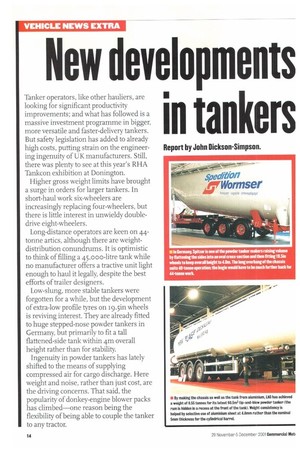New developments in tankers
Page 14

If you've noticed an error in this article please click here to report it so we can fix it.
Tanker operators, like other hauliers, are looking for significant productivity improvements; and what has followed is a massive investment programme in bigger, more versatile and faster-delivery tankers. But safety legislation has added to already high costs, putting strain on the engineering ingenuity of UK manufacturers. Still, there was plenty to see at this year's RHA Tankcon exhibition at Donington.
Higher gross weight limits have brought a surge in orders for larger tankers. In short-haul work six-wheelers are increasingly replacing four-wheelers, but there is little interest in unwieldy doubledrive eight-wheelers.
Long-distance operators are keen on 44tonne artics, although there are weightdistribution conundrums. It is optimistic to think of filling a 45,000-litre tank while no manufacturer offers a tractive unit light enough to haul it legally, despite the best efforts of trailer designers.
Low-slung, more stable tankers were forgotten for a while, but the development of extra-low profile tyres on 19.5in wheels is reviving interest. They are already fitted to huge stepped-nose powder tankers in Germany, but primarily to fit a tall flattened-side tank within 4m overall height rather than for stability.
Ingenuity in powder tankers has lately shifted to the means of supplying compressed air for cargo discharge. Here weight and noise, rather than just cost, are the driving concerns. That said, the popularity of donkey-engine blower packs has climbed—one reason being the flexibility of being able to couple the tanker to any tractor.
































































































































































